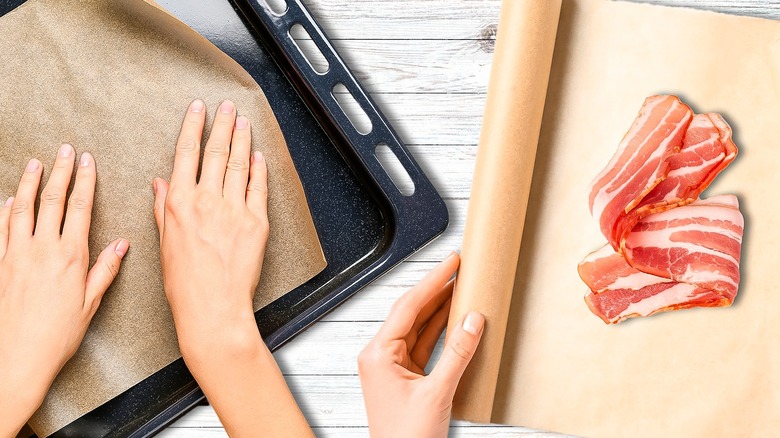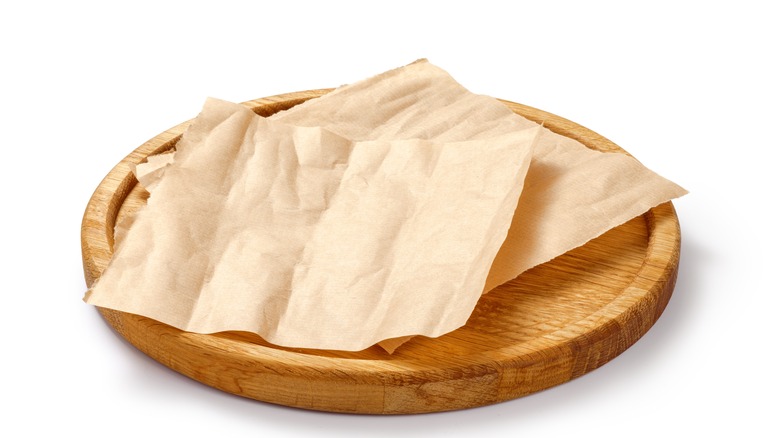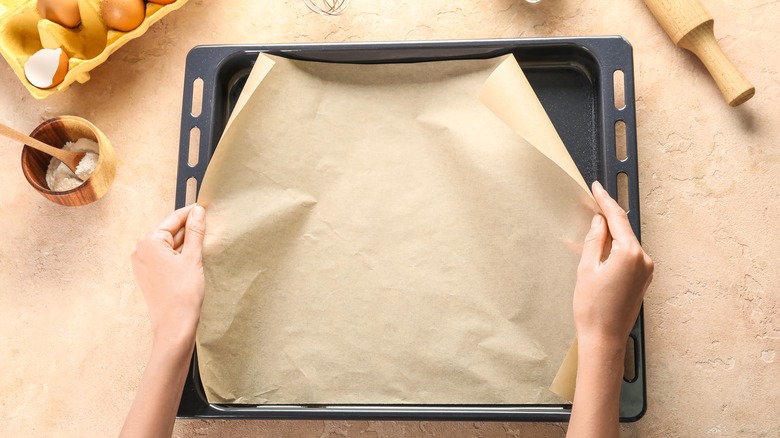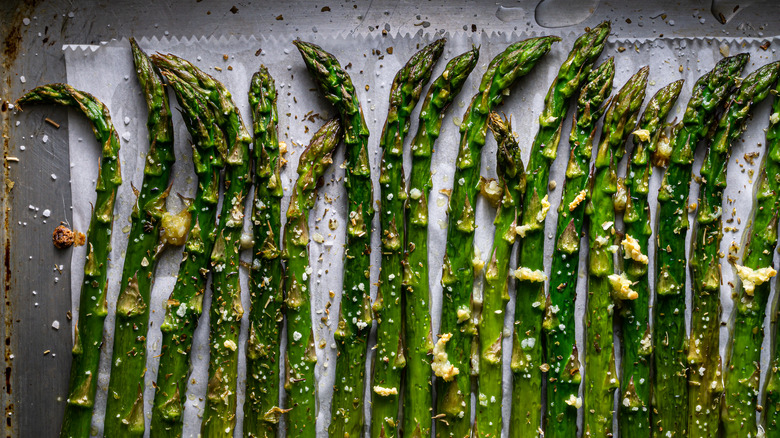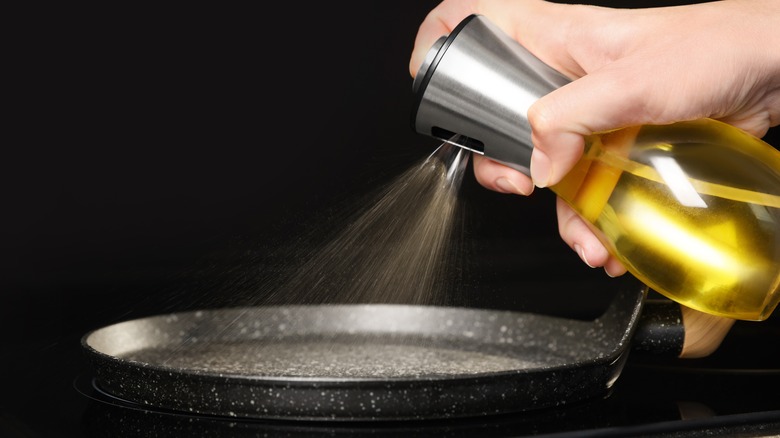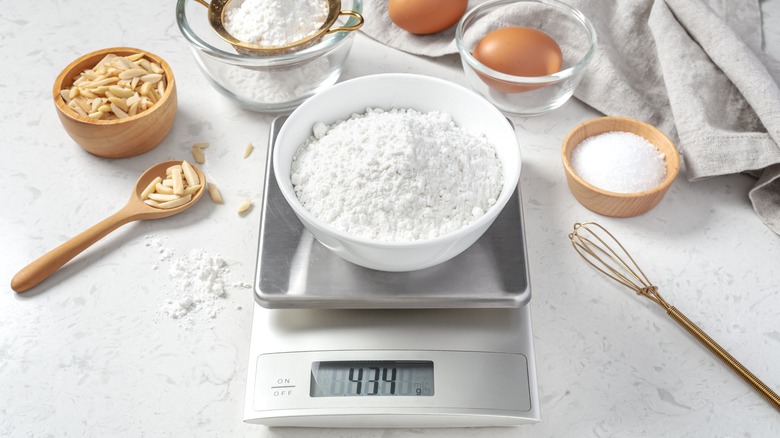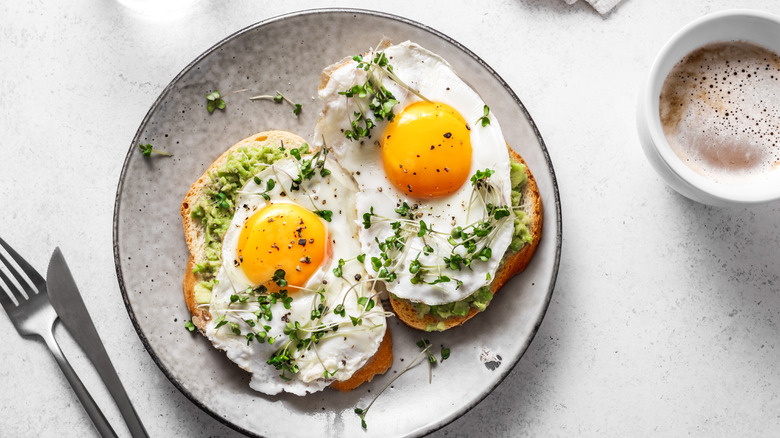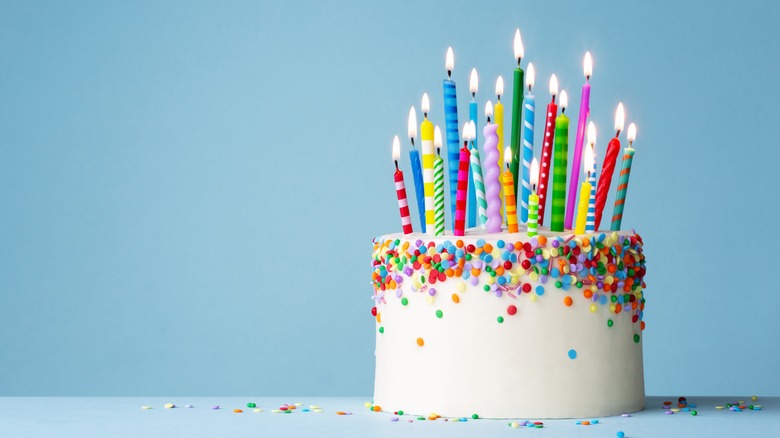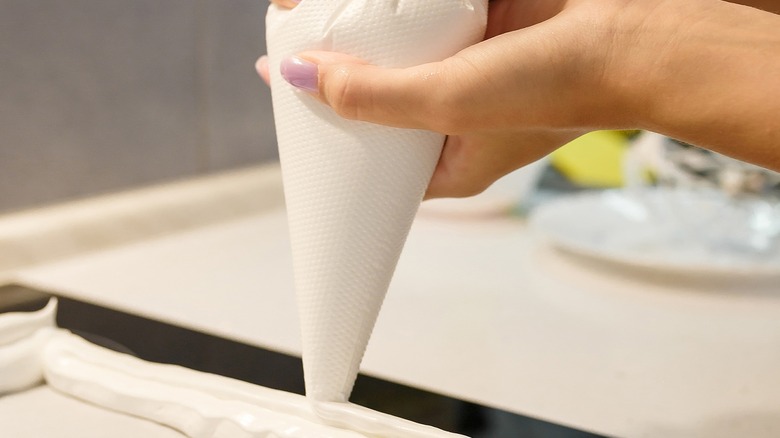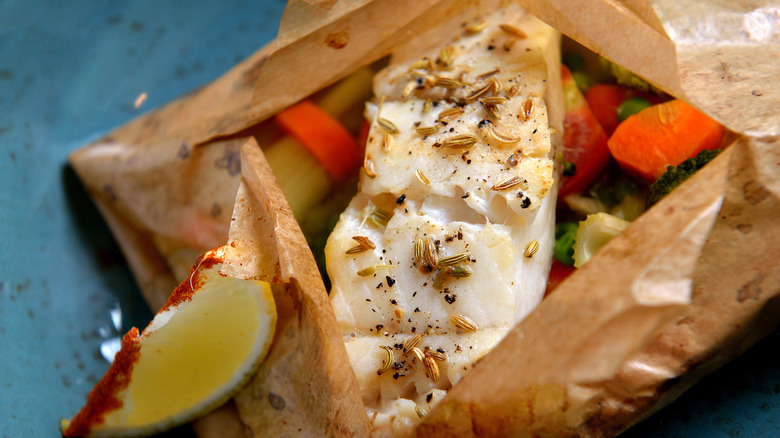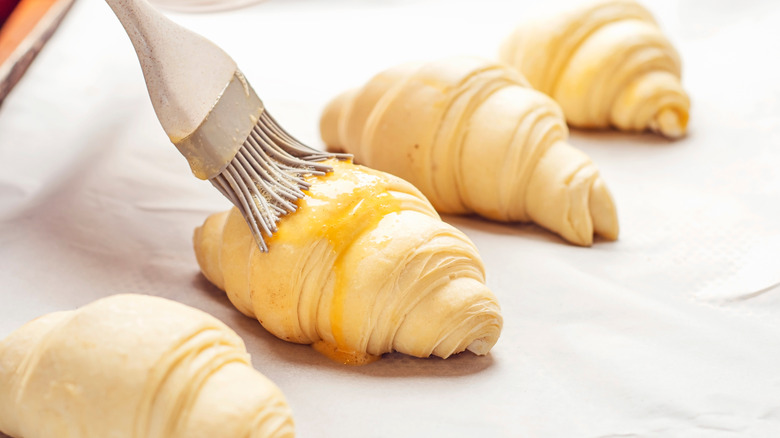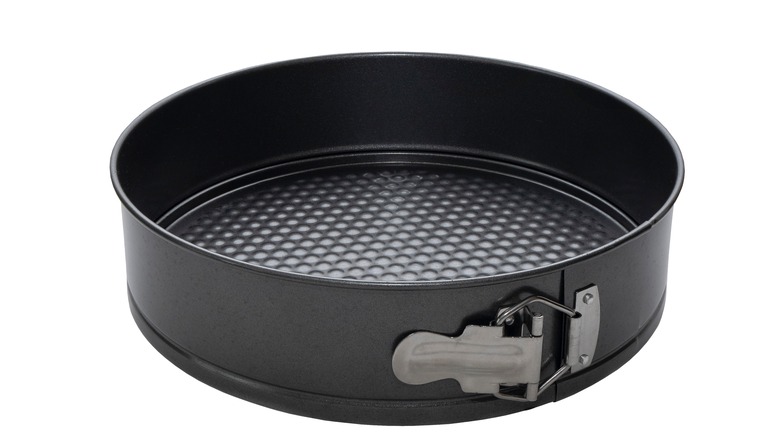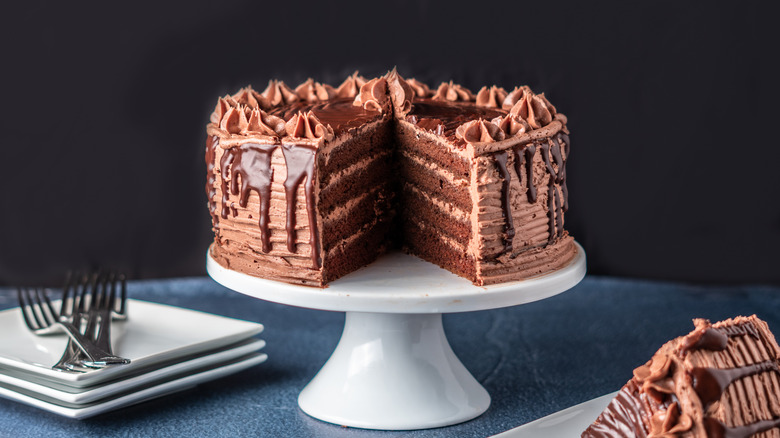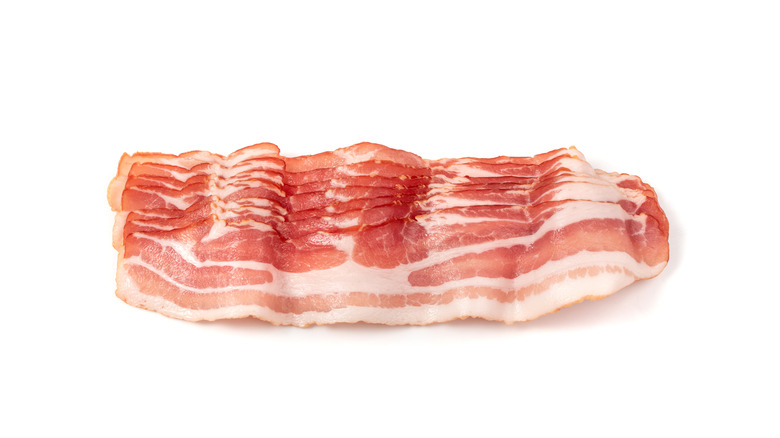17 Parchment Paper Hacks You'll Wish You Knew Sooner
Ingredients are not the only tools you'll need before embarking on a recipe. You'll also need utensils, appliances, and parchment paper. As a staple in kitchens around the world, this versatile material stands as an indispensable ally for both seasoned chefs and novice bakers. Crafted from treated paper, its non-stick properties make it a game-changer in the kitchen. Its ability to create a barrier between food and surfaces ensures an effortless release, preventing delicate pastries from adhering to pans and simplifying the aftermath of savory roasts.
The uses of parchment extend beyond its non-stick prowess. Its heat-resistant qualities make it an ideal companion for baking, safeguarding delicate doughs from the intense heat of the oven while maintaining a consistent and even temperature. Moreover, its role in creating packets for cooking en papillote showcases its ability to infuse flavors and lock in moisture. It can also be used to make all sorts of culinary ventures easier and more practical, whether you're icing a cake or grappling with pastry cream. So let us take a look at some of the most useful aspects of this beloved material.
Crumple it before flattening
You have probably noticed that parchment paper comes rolled up in a long, rectangular box. While this helps you save space in your shopping cart and your pantry, it also means you'll have to somehow unfurl that paper — which has been sitting in that position for months or even years — and flatten it out before using it. This is no small task.
But there is an easy fix: Just cut off the section of parchment paper you intend to use, crumple it into a big messy ball, and then flatten it over your pan or cake tin. You'll see that it'll be much easier to bend the paper to your will once you've broken down its spirit. Although you'll end up with a messy-looking thing, its appearance is not important, as you can always separate it from whatever it is you are making before you serve the dish or dessert.
Never use it with a broiler
Broilers are the hottest functions most ovens can provide. They reach temperatures upward of 550 F, which is far and above the usual 325 F or 400 F you might use for most of your other oven needs. As such, it's important to be mindful of what materials you place under them. Parchment paper, for one, with its heat resistance properties, might be perfect for lining a cake that cooks at 350 F on a lower shelf in the oven, but it is paper after all, and placing it directly under a broiler set to maximum heat might be playing with fire — literally.
Indeed, heat resistant is not the same as heat proof, and parchment paper can and does catch fire under broilers. Therefore, it's best to play it safe and line your pan for broiling with something a little sturdier, like aluminum foil.
Cut it into cartouches
Knowing how to prepare and use a cartouche can save you a lot of effort in the kitchen. You may have heard the word before in the context of bullets or scrolls. That's not what we're talking about here. In the culinary realm, a cartouche is just a round cutout of parchment paper, which is often placed at the bottom of a cake tin in the place of butter or flour to make sure the batter doesn't stick to the bottom.
But once you try a cartouche, you can never go back, and you might want to use it for other projects, too. For example, some French chefs place one on the top of pots containing poaching fish or steaming vegetables instead of a metal lid. This helps provide a smoother cooking process, as metal lids can cause heat and steam to gather unevenly. The cartouche can help in the same way in many different recipes, including for sauces, rice pilaf, or baked fruit.
Avoid it when roasting vegetables
Parchment paper can be a catchall oven material, one that will make your roasting process easier and simpler to clean up. But that doesn't mean you should use it for absolutely everything. In fact, you might want to avoid using parchment paper at all when roasting vegetables. Although lining your baking sheet with parchment paper isn't going to kill you, it can prevent your vegetables from browning, which would be a shame.
That's because the heat-resistant properties of the parchment paper create a buffer between the heat of your baking sheet and the vegetables lying upon it, lessening any browning and caramelization effects that might occur. Although the presence of parchment paper will lessen your cleaning load, the costs to the flavor outweigh the benefits. The answer is to skip all the kitchen paper or aluminum and place your vegetables directly on your baking sheet.
Spray cooking oil under it
Parchment paper is all about the non-stick properties — which is what makes it such a great material to stick right between your cake tin and your cake batter before everything goes in the oven. But in some situations, this blessing can be a curse in disguise. The non-stick element in the parchment paper that helps you lift your cake effortlessly out of the tin is the same one that also causes the paper to curl up on the edges and shift around aimlessly as you're trying to work with it.
Luckily, there is a quick and easy solution to this problem. Just take a little neutral oil, butter, or cooking spray and apply it to the bottom of the sheet pan, cake tin, or whatever you're lining, and you'll see that the parchment paper will finally comply and stay in place.
Use it to catch wayward ingredients
The joys of baking are widely known, but then there's clean-up time, which is a little less enjoyable. That's when you realize how much flour you spilled over the counter. Taking care of it is a tough job, but someone has to do it. But actually, maybe they don't. Maybe we have the perfect hack for skipping the clean-up part altogether and still end up with a clean kitchen.
The hack in question involves parchment paper. All you have to do is lay a large section of it flat on your countertop and measure your dry ingredients over it. That way, if you spill a bit of sugar, you can pick it up using the paper and funnel it back into its container. You may have solved this problem by measuring your ingredients over your mixing bowl, but if you spill extra flour into the contents, you'll end up with the wrong measurements and a ruined cake. Indeed, you may as well measure all ingredients over parchment paper, including something like molasses, which you don't want sullying your pristine countertops.
Reuse it or lose it
Many people use a sheet of parchment paper once and then throw it away. This is understandable if the paper has been sitting under a gooey pie for an hour in the oven, or if it's covered in chicken juices from a roasting job. But there are instances where you can save and reuse your parchment paper, rescuing your wallet as well as the environment. In fact, while parchment paper may seem biodegradable, the wax and silicone it contains make it non-compostable and non-recyclable.
Thus, reusing parchment paper as many times as it will hold is an ideal solution. An example of when this could be especially beneficial is when you're making several batches of cookies. There's no need to replace the parchment paper for each batch, as it will hardly have gotten dirty from a batch of cookies. Another way to reuse it is by scraping any residual cake from the paper with a bench scraper. Just bear in mind that it's best to use this technique with cakes or baked goods rather than fish or meat, which could leave dangerous germs behind.
Fry your eggs on it
You're in the mood for fried eggs this morning, but you realize you don't have any non-stick pans. You're tired of always getting your eggs stuck on the bottom of your regular pans, so you're in a bind. Or perhaps not. Perhaps you can just place a sheet of baking paper over your pan, top it with butter or cooking oil, and then crack an egg over it once it's nice and hot. Then cover the pan with a lid and wait for the egg to cook to your liking.
This fried egg method is easy and mess-free, as the parchment paper will protect your pan from any goo issuing from the eggs. You can use it to fry many other items besides eggs, including fish, burgers, or any ingredient that doesn't require a lot of flipping or stirring. It also means you won't have to go out and buy a non-stick pan.
Employ it for mess-free cake presentations
If you've ever seen a cake on display at a pastry shop and thought it was fake, you wouldn't be the first. Their icing and overall presentation sometimes look so perfect that you think it couldn't possibly be real. Especially if all you end up with is a hot mess every time you try to frost a cake. But it is real because what's actually going on, is professional pastry chefs have a few tricks up their sleeves for achieving the perfect presentation for their cakes.
One such trick, which comes courtesy of Ina Garten, is to cut some parchment paper into square sections, cut those into triangles, and place those triangles on a cake stand before placing the cake on top of it, making sure they overlap and stick out from under the cake so they can catch any icing that falls off. Once you're done, just pull the triangles out (using a paring knife to remove them if they don't come out easily) and you'll be left with an iced cake and a mess-free cake stand.
Roll it into a pastry bag
A lot of people don't have specialized pastry-making tools sitting around at home. In this era of tiny houses and small city kitchens, who has the space to keep a bunch of tools that can only be used for a single purpose? This is why there is no need to buy a pastry bag or piping cone if you don't make pastry cream very often. Instead, you can just take a sheet of parchment paper, roll it into a funnel, and squeeze out your pastry cream through the opening at the bottom.
To pull off this nifty little trick at home, cut your parchment paper into a triangle and then fold it into a funnel. You may want to fold the top over after putting the cream in so it can't get out that way. Then simply pipe your product onto your baked good or pastry. Just bear in mind that you won't be able to put a lot into this type of piping bag. The parchment paper won't hold as well as a bag made for this purpose, so you'll only be able to use a small amount at a time.
Fashion it into cupcake liners
If you've ever embarked on a cupcake-making project only to abandon it because you realized you didn't have any cupcake liners, then this tip is for you. The fact is, you don't really need specialized cupcake liners at all. First of all, you can simply put butter and flour in your cupcake tin to prevent sticking, but if you're hell-bent on putting something physical in there, you can simply cut up your parchment paper and fashion it into perfectly functional cupcake liners.
You may have seen this at coffee shops or pastry shops — in these cases, the liners are typically made with brown paper. But you can do the same thing with your own, regular parchment paper. Just cut your paper into small squares and press them into your cupcake tray. As a bonus, when your cupcakes are ready, they'll be surrounded by a lovely golden hue.
Learn to cook en papillote
En papillote is a fancy French term to describe food that is cooked while wrapped in parchment paper. But don't let the name intimidate you. Just because it's French, doesn't mean it's complicated. In fact, all you have to do is prepare a sheet of parchment paper for each serving, place your fish or other protein in the center, along with any vegetables or herbs you want to add (ensuring they're the type that will cook as quickly as your protein, like cherry tomatoes), then folder over the paper, making sure everything is tightly bundled up.
This step is key: if there are any gaps, the heat and moisture will escape, and you won't be able to steam cook your dish. Finally, place the bundles of joy in the preheated oven until they have puffed up and darkened. Wow your guests by serving the meal directly on paper placed on a plate.
Snip it into a pastry brush
No one ever died from not having a pastry brush at home, or at least we hope not. Especially since one can easily be made with a few creative manipulations of parchment paper. The instructions are simple: cut your parchment paper into a 12-inch strip, fold it over twice, cut the short end into ½-inch bristles, then unfold the long end once and use that as a handle.
You'll end up with a fairly flimsy brush, but it's quick, easy, and cheap to make, and it'll get the job done in a pinch. If you find that the bristles you cut are stuck together or too rigid, you can loosen them up with your fingers before dipping them in your egg wash or glaze. Also be sure to work quickly when using this makeshift brush, as parchment paper is spongier than silicone, and the liquid you're using may soak through it.
Line the interior of your cake tin with it
Parchment paper comes in long sheets that can easily be cut into squares or rectangles, but many cake tins are round, which can present a problem if you're trying to use parchment paper to line one. Although some people use the cake tin to trace a circle on the parchment paper to make the appropriate shape, this then presents the problem of having to cut in a circle, which is not an easy thing to do.
Rather, Ina Garten's parchment paper hack involves folding a rectangular piece in half twice to create a square, then folding it diagonally twice to create a triangle. Place this triangle on your upside-down tin, pointy part inward, and cut off the part of the paper that hangs over the edge of the tin. Unfold the paper and you'll see that it has magically become round.
Cover your cakes with it to retain moisture
As good as your last birthday cake may have been, you may not have been able to eat it all in one sitting, especially if you only hosted a small gathering to celebrate. Or maybe you have a coffee cake sitting at home that you just shared with two friends at tea time. Either way, you've probably had to deal with the problem of leftover cake at some point in your life and of how to best store it to keep it from going stale.
One way to solve this problem is to put the cake in a cake box. But it's okay if you don't have one, because you can also use our parchment paper hack on the cake, which involves cutting a small rectangle of paper and using it to cover the exposed sections of the cake — meaning the parts where the cake was sliced open. Just be sure to press the paper in so that it sticks to the moist cake and protects it from the air.
Adopt it as a de-greaser
Store-bought chicken stock is fine for ease and convenience, and some of it can even be quite good, but nothing beats the homemade version, packed with chicken flavor, fat, and a bit of grease, which can come in handy for certain recipes. But sometimes a stock can accumulate too much grease, especially if you're a proponent of using chicken skin. In these cases, you don't have to just swallow the pill and put up with it. You can use a quick parchment paper hack to degrease it.
All there is to do is blot the top of the stock with some parchment paper, making sure you don't dip it too deeply into the liquid. Once the paper is in place, drag it lightly across the surface to collect all the grease, then scoop up any remaining goo with a spoon.
Wrap it around bacon for storage
Opening a fresh packet of bacon is always a good feeling until you realize you don't need to use all of it at once, and the problem of what to do with the rest imposes itself. You might be able to fit it into a resealable bag, but for maximum freshness, you must turn to parchment paper. Plus, this trick is even better because you can take only the rashers you need, and the rest will remain safely tucked inside the parchment paper, where it stays fresh for longer.
That's because the bacon rashers will be individually wrapped in parchment paper. To make that happen, just lay a long sheet of parchment paper on your countertop, place the bacon strips on top, leaving an inch between each one, then fold the paper up from the long side, curling the bacon strips in on themselves. Once you have a long tube of spaced-out bacon bits, cut the paper between each rasher and place them all in a resealable bag, still wrapped in their paper.
